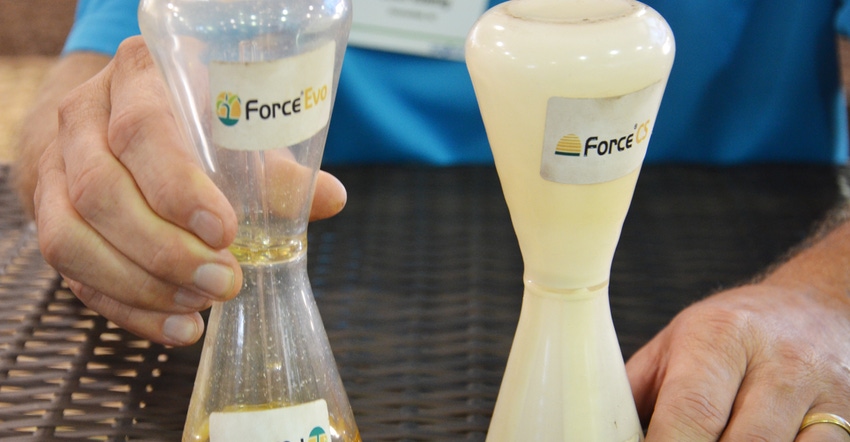
John Koenig sat two glass flasks on the table. One held a milky liquid. The other held a colored liquid that was free of any milky appearance. He said the best way to understand why a change in formulation for Force insecticide is a big deal is to see it for yourself. Seeing is believing, and it’s obvious the two formulations are different.
Koenig, a Syngenta researcher, says the new Force Evo corn insecticide was developed so the product would be more compatible with liquid starter and pop-up fertilizers. The previous formulation killed insects effectively, but sometimes it was harder to clean out after use than some people thought it should be.
So far, Syngenta hasn’t found any liquid or pop-up fertilizer that isn’t compatible with Force Evo in lab tests, he says. Plus, Syngenta worked with John Deere and Raven to develop simple, efficient, closed-application systems for Force Evo insecticide. It comes as a “bag in a box” product and should never be opened or directly added to starter fertilizer tanks, Syngenta says.
Force Evo has been approved by the EPA. Contact your Syngenta representative for rates.
Spray beyond V4
Sometimes the weather puts a damper on herbicide spray timing to control weeds in corn. A new herbicide from Amvac broadens that window by allowing spraying from corn emergence to 12 inches.
ImpactZ controls broadleaves and grasses, including glyphosate-resistant waterhemp, marestail, Palmer amaranth, giant ragweed and kochia.
Unlike other HPPD herbicides, there are no restrictions on soil types or tankmixes, and no herbicide sensitivity with ImpactZ. Farmers can apply early in the season or anytime weeds emerge from spike to V5. Contact Amvac at 888-462-6822 or amvac-chemical.com.
Fungicide seed treatment
Lumisena fungicide seed treatment from DuPont provides control of phytophthora in soybeans and downy mildew in sunflower. The active ingredient in Lumisena, oxathiapiprolin, controls pathogens during multiple stages of their life cycle. The result is healthier plants that emerge quickly and develop strong root masses.
In DuPont research trials, soybean seed protected with Lumisena had 32% less Phytophthora sojae incidence than untreated seed. In sunflowers, DuPont trials showed seed treated with Lumisena had 76% to 96% less downy mildew compared to untreated seed, and 20% to 41% less downy mildew compared to conventional fungicide seed treatments.
Yield enhancer product
Fortified Stimulate Yield Enhancer Plus from Stoller USA contains a proprietary blend of four bio-identical growth-regulating hormones that the company claims will enable optimal yields in numerous field crops including soybeans and corn. A ratio of 2-1-1 of cytokinin, gibberellin and IAA auxin/IBA auxin is maintained and allows a quick-acting auxin effect for developing maximum yield. According to Stoller Market Development Agronomist Rob Jerek, the two different kinds of auxins make it different from other products in the marketplace.
Sugar supplement
Some consultants have experimented with sugar to boost plant growth in various situations. A new product, Sugar E-Boost, claims to give crops a boost of energy. This newly formulated concentration packs in 6.4 pounds of sugar per gallon, which means almost a pound of sugar in every pint application. Apply Sugar E-Boost at planting, or add it to your herbicide, insecticide and fungicide applications.
The formulation doesn’t freeze or crystalize, which are common challenges with other sugar products, so it stores well. The cost is roughly $1 per acre. For more information, contact Soil Service Inc., Niota, Ill., at 888-313-2360, or visit soilserviceinc.com.
Farm Progress editors Curt Arens, Jill Loehr and Mindy Ward contributed to this column.
About the Author(s)
You May Also Like




